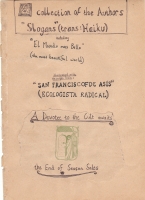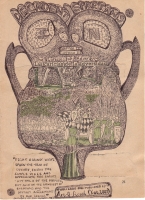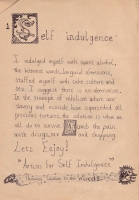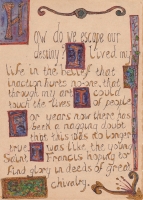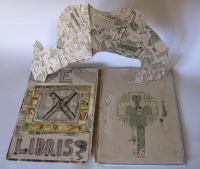Recyclopedia, Volume 2: User´s Guide
A collection of Haiku, a catalogue of decadent spartans.
When I salvaged the book “The Life of Saint Francis” from destruction at the Rastro it held little interest beyond the monochrome illustrations- it was the life and temptations of Saint Anthony that I was interested in and I planned to use the book to carry out a long held desire to write a modern version of the temptations, .
I had spent around two months travelling with the book “The Life of Saint Francis”, its binding slowly unravelling, its faded pages coming looser while I tried to engage with the imagery, doodling in the margins and painstakingly decorating each chapter heading. But it was only when I was at my wits end and got the scalpel out, cutting those images from their support, that I finally decided I should read his story before I destroyed it entirely.
I knew pieces of the story of Saint Francis- his “misspent youth” chasing dreams of glory as a knight, the sermons he preached to birds and fishes, but despite the fact I’d subtitled the book “Radical Ecologist” I was still hung up on the story of Saint Anthony and perhaps I was in denial.
But then feminism came along. If I carried out my plan I’d be writing one life on top of another, in the typical style of male historians so it was definitely time to buckle under and actually read about this guy...
Una colección de jaikus, un catálogo de espartanas decadentes. Cuando salvé el libro de la destrucción en el rastro tenía poco interés en otra cosa que no fueran las ilustraciones porque la única historia de santos que me atraía eran las tentaciones de san Antonio y había planeado utilizar el libro para escribir una versión moderna de las tentaciones.
Pasé dos meses viajando con el libro "La Vida de San Francisco", tratando de entenderme con sus imágenes mientras la encuadernación se iba deshaciendo lentamente y las páginas descoloridas iban desprendiéndose del lomo. Hacía garabatos en los márgenes y decoraba con mucho esfuerzo cada inicio de capítulo. Pero al final, cuando ya no pude aguantar más saqué el bisturí, fui recortando las imágenes de su soporte, y decidi leer la historia antes de destruirlo totalmente.
En este momento ya había leído trozos de la historia y conocía que en su adolescencia San Francisco había estado buscando la gloria como caballero; sabía también, de los sermones que había predicado a los peces y a las aves pero a pesar del haber puesto de subtítulo " Ecologista radical" la verdad es que realmente estaba más interesado en contar la historia de San Antonio.
Pero según el feminismo esto sería escribir una vida "encima" de otra -una práctica típica de los historiadores masculinos-: así que definitivamente había llegado la hora de investigar más sobre la vida de San Francisco.

